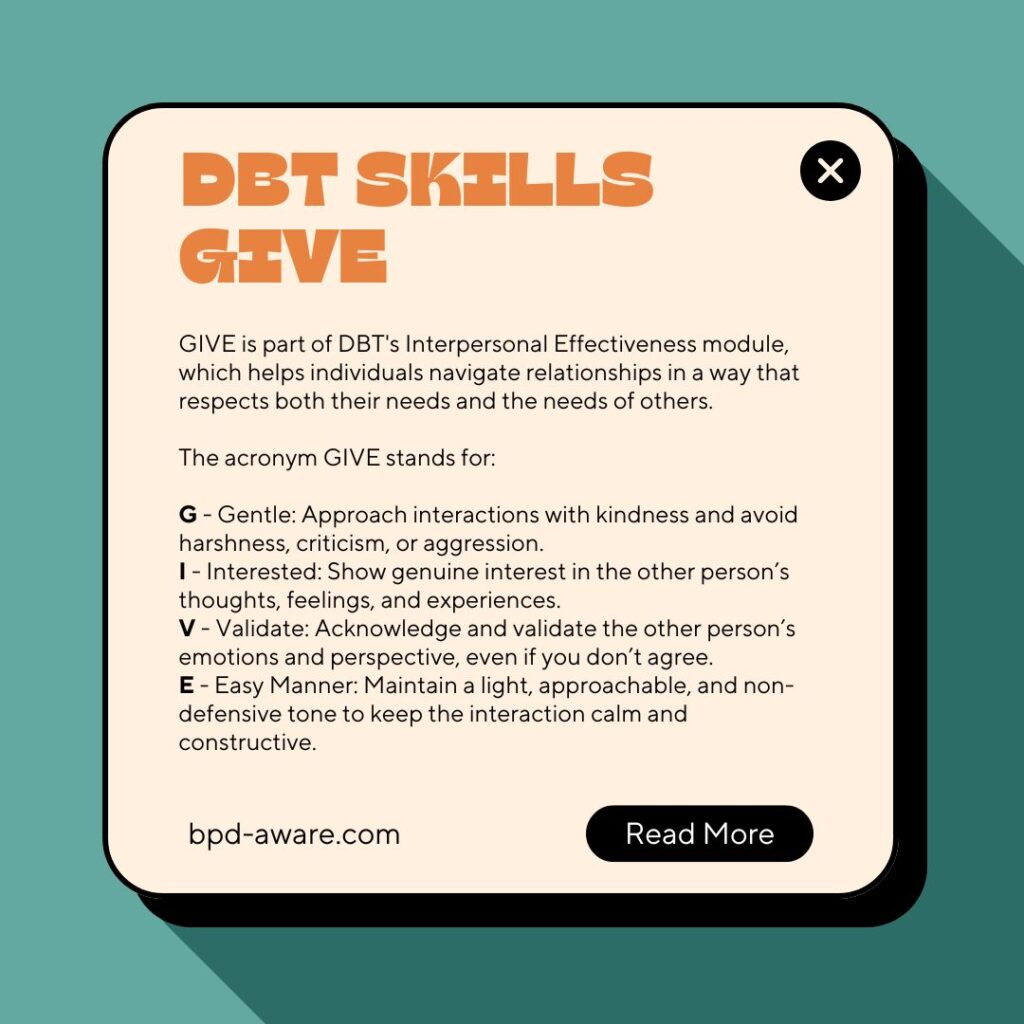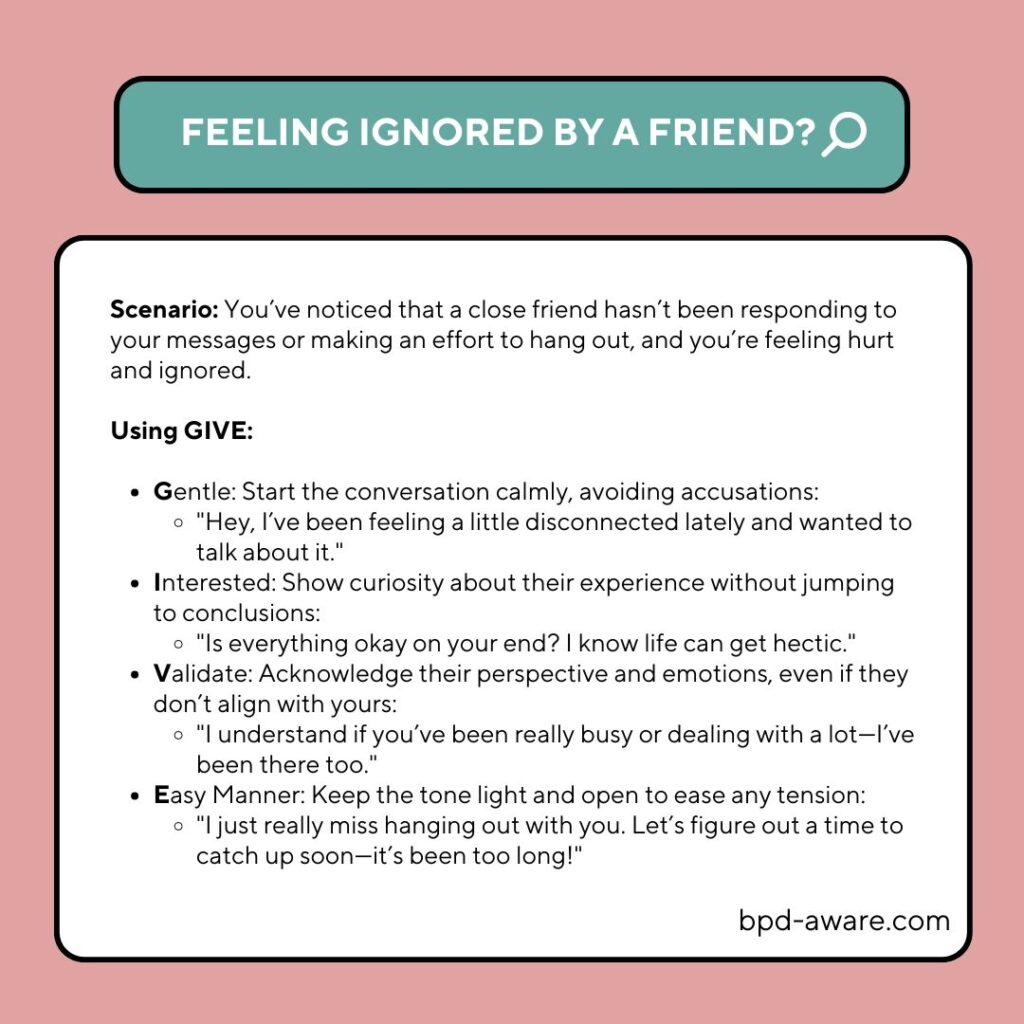Dialectical Behavior Therapy (DBT) is a therapeutic approach developed by psychologist Marsha Linehan to help individuals with intense emotional experiences, especially those living with borderline personality disorder (BPD). BPD is characterized by difficulties in regulating emotions, maintaining stable relationships, managing self-image, and several other symptoms. DBT provides a structured way to build life skills in mindfulness, emotion regulation, distress tolerance, and interpersonal effectiveness.
People with BPD struggle with maintaining stable relationships. Many individuals with BPD have grown up in an unstable environment that didn’t provide them with the emotional support, stability, and validation they needed. These are all critical components in learning what makes for healthy communication skills and relationships.
One of the cornerstones of DBT is improving interpersonal skills. Strong interpersonal skills are vital as they can help you to more easily overcome negative events in relationships, boost mutual respect, set healthy boundaries, and overall strengthen relationships. They can also help you to learn when someone else is acting in bad faith.
One of the DBT skills designed to help improve interpersonal skills is known as GIVE, and this is the skill we will focus on in this article.
What is the GIVE Skill?
The GIVE skill focuses on maintaining and improving relationships. It’s particularly useful when the goal is to strengthen emotional bonds or preserve a valued relationship, even in the face of conflict. GIVE stands for:
- Gentle Approach: Approach the conversation with kindness, avoiding harshness, judgment, or threats.
- Interested Attitude: Actively listen to the other person, showing genuine curiosity about their thoughts and feelings.
- Validate the Other Person’s Thoughts and Feelings: Acknowledge and validate the other person’s emotions and experiences, even if you don’t agree with them.
- Easy Manner: Use a relaxed, approachable, and friendly tone to keep the interaction calm and constructive.

How GIVE Can Help
The GIVE skill promotes positive communication, reducing misunderstandings and fostering trust. It encourages individuals to focus on preserving relationships by emphasizing empathy, mutual respect, and patience. This skill can be especially transformative for those with BPD, who may struggle with impulsivity or intense emotional responses during conflicts.
Practicing GIVE helps individuals:
- Navigate emotionally charged situations without escalating conflict.
- Build rapport and deepen emotional connections.
- Reduce the likelihood of interpersonal burnout and resentment.
- Balance self-assertion with relationship care.
How to Practice the GIVE Skill
Here are steps to effectively incorporate GIVE into daily interactions:
- Start with Self-Awareness
- Before engaging in a challenging interaction, take a moment to assess your emotional state. If you’re feeling overwhelmed, use distress tolerance skills to calm yourself before practicing GIVE.
- Be Gentle
- Use a soft tone of voice, and avoid sarcasm or criticism.
- Avoid statements that could be perceived as blaming or accusing.
- Example: Instead of saying, “You never listen to me,” say, “I feel unheard sometimes, and I’d like to talk about it.”
- Show Interest
- Maintain eye contact, nod occasionally, and respond thoughtfully.
- Ask open-ended questions to demonstrate curiosity and investment.
- Example: “How do you feel about this situation?” or “Can you tell me more about what you’re thinking?”
- Validate
- Acknowledge the other person’s perspective, even if it differs from yours.
- Use statements like:
- “I can see why you might feel that way.”
- “It makes sense that you’d be upset.”
- Validation shows you value their feelings, which fosters trust and connection.
- Use an Easy Manner
- Stay calm and approachable, even when discussing difficult topics.
- Smile when appropriate, use humor to lighten the mood, and avoid defensive body language.
- Example: Instead of a tense response, try saying, “I get where you’re coming from—let’s work through this together.”
- Reflect and Adjust
- After the interaction, reflect on what went well and what could be improved. Practicing GIVE consistently will make it feel more natural over time.
Here are some real-world examples of using the GIVE skill in different types of relationships and scenarios:
Example 1: Conflict with a Partner
Scenario: Your partner forgot to pick you up after work, and you feel hurt and angry.
Using GIVE:
- Gentle: Instead of shouting, start with a calm tone: “Hey, I wanted to talk about what happened earlier.”
- Interested: Ask about their perspective: “What happened? Was something going on that I didn’t know about?”
- Validate: “I get that you were really busy and might have lost track of time.”
- Easy Manner: Smile gently, keep your posture open, and avoid an accusatory tone: “It’s okay; I just felt stranded and worried. Let’s figure out how to prevent this in the future.”
Example 2: Helping a Friend in Distress
Scenario: Your friend is upset about a failed job interview and says, “I’m such a failure; I’ll never get a good job.”
Using GIVE:
- Gentle: Avoid dismissing their feelings or lecturing them. Say, “I’m really sorry you’re feeling this way.”
- Interested: Show curiosity about their experience: “What happened during the interview? What parts felt the hardest?”
- Validate: “It makes sense that you’d feel disappointed. Interviews can be really tough.”
- Easy Manner: Use a calm and warm tone: “You’ve got this. Let’s brainstorm for the next one over coffee—it’ll help you feel more prepared.”
Example 3: Addressing a Work Disagreement
Scenario: A coworker overlooked your contribution in a team meeting, and you feel undervalued.
Using GIVE:
- Gentle: Approach them without hostility: “Hey, can we chat for a moment? I wanted to talk about something from the meeting.”
- Interested: Invite their perspective: “How did you feel the discussion went? Were there any points you think we missed?”
- Validate: “I can see you were focused on the project’s big picture, and I appreciate how much effort you’re putting in.”
- Easy Manner: Maintain a professional but friendly demeanor: “For next time, it would mean a lot if we could highlight everyone’s contributions, including mine, to ensure the team feels recognized.”
Example 4: Setting Boundaries with a Family Member
Scenario: A family member repeatedly comments on your life choices, and you want to address it without causing tension.
Using GIVE:
- Gentle: Begin with a non-confrontational statement: “I love that you care about me and my choices.”
- Interested: Encourage them to share their perspective: “What’s making you feel so strongly about this?”
- Validate: “I understand that you want the best for me and that you’re coming from a place of love.”
- Easy Manner: Lighten the mood without invalidating their feelings: “Let’s agree to trust each other a bit more—besides, life would be boring if we all made the same decisions!”
Example 5: Dealing with a Stranger or Acquaintance
Scenario: A stranger cuts in front of you in line, and you want to address it politely.
Using GIVE:
- Gentle: Avoid a harsh tone: “Excuse me, I think I was ahead in line.”
- Interested: Be curious rather than accusatory: “Did you realize where the line starts? It can be a little confusing.”
- Validate: Acknowledge the possibility of a mistake: “It’s easy to lose track in a busy place like this.”
- Easy Manner: Smile slightly and keep your body language neutral: “No worries—just wanted to let you know where the line begins.”

Final Thoughts
The GIVE skill in DBT is a powerful tool for improving interpersonal effectiveness, particularly for individuals with Borderline Personality Disorder. By focusing on gentleness, genuine interest, emotional validation, and maintaining an easy demeanor, individuals can transform their communication patterns, build stronger relationships, and enhance their emotional well-being.
Whether you’re working through DBT with a therapist or exploring these skills on your own, GIVE can help create the foundation for healthier, more fulfilling relationships.
Sources, Resources, and Further Reading
- What Are Interpersonal Skills? And How to Strengthen Them: https://www.coursera.org/articles/interpersonal-skills
- 10+ interpersonal skills at work and ways to develop them: https://www.betterup.com/blog/interpersonal-skills-at-work
- Interpersonal problems and negative affect in Borderline Personality and Depressive Disorders in daily life: https://pmc.ncbi.nlm.nih.gov/articles/PMC5436804/
- Why is it so hard to communicate with Borderline Personality Disorder?: https://missmisery.blog/2019/03/11/why-is-it-so-hard-to-communicate-with-borderline-personality-disorder/
















